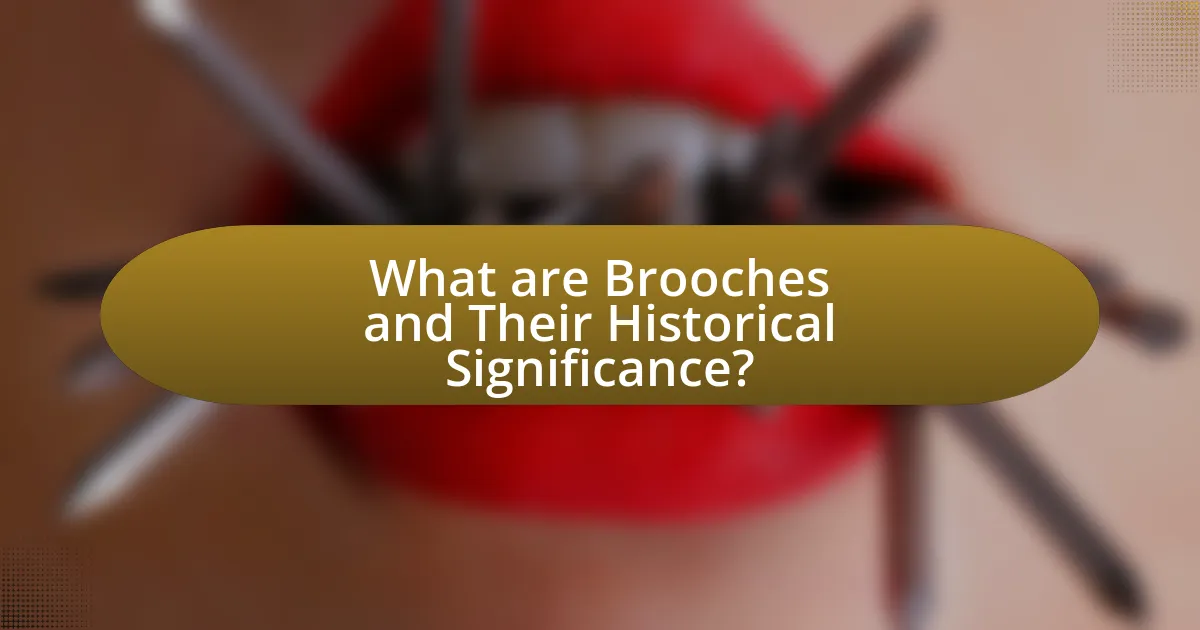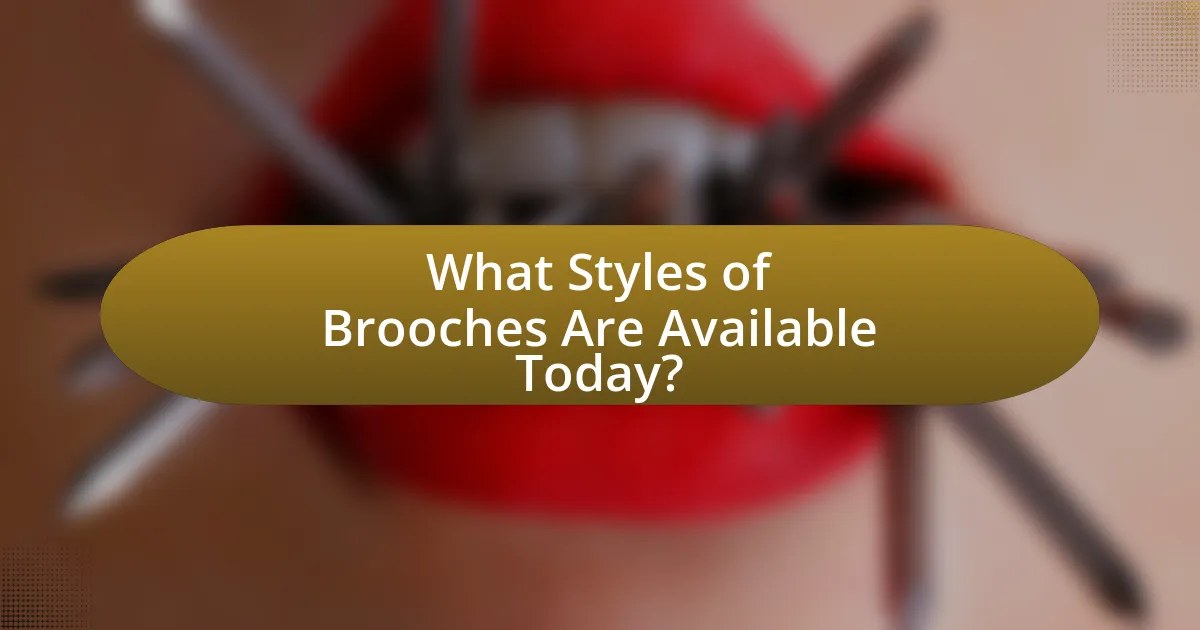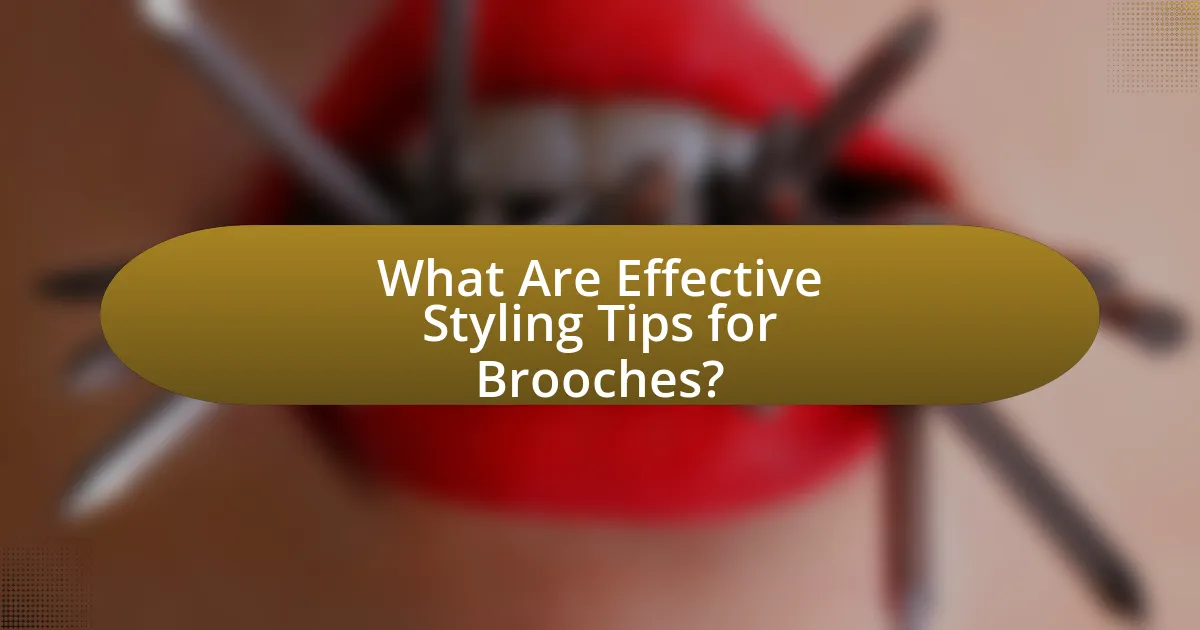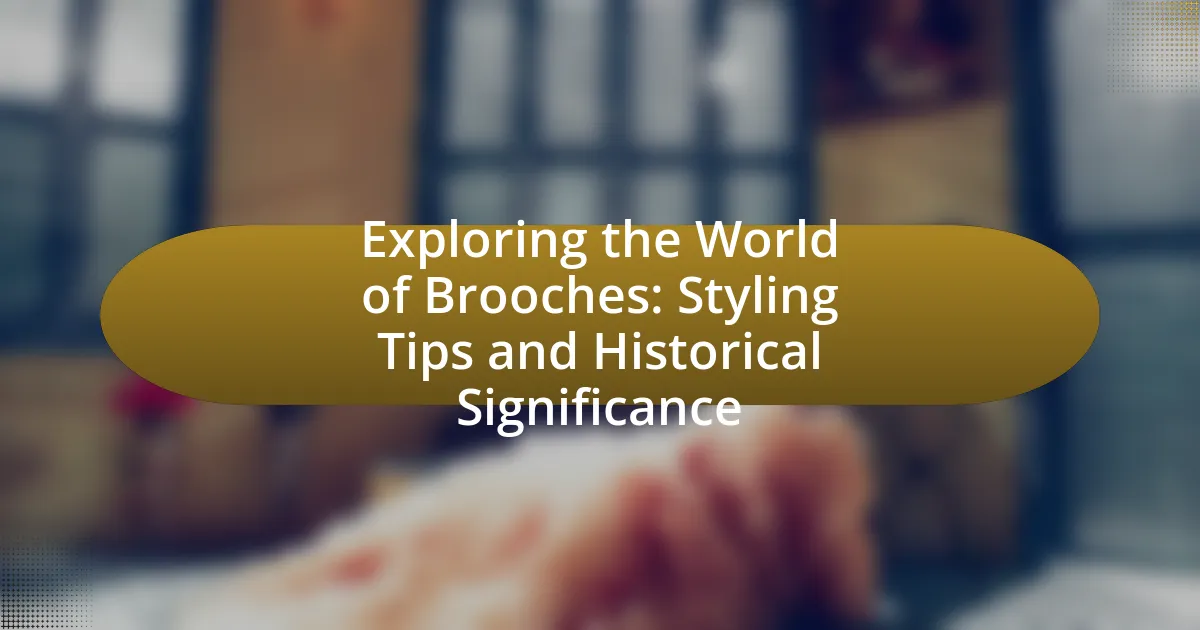Brooches are decorative jewelry items with a rich historical significance, serving both functional and aesthetic purposes since ancient times. This article explores the evolution of brooches from practical fasteners in the Bronze Age to ornate fashion accessories that symbolize status and personal expression throughout various historical periods. It examines the cultural influences that shaped brooch designs, the different styles available today, and effective styling tips for incorporating brooches into modern outfits. Additionally, the article provides practical advice on caring for and storing brooches, ensuring their longevity and maintaining their appeal.

What are Brooches and Their Historical Significance?
Brooches are decorative jewelry items designed to be attached to garments, often serving both functional and aesthetic purposes. Historically, brooches date back to ancient times, with evidence of their use in various cultures, including the Celts and Romans, where they functioned as fasteners for cloaks and garments. The significance of brooches extends beyond mere adornment; they have symbolized status, identity, and personal expression throughout history. For instance, during the Middle Ages, brooches were often intricately designed and used to convey wealth and power, while in the Victorian era, they became sentimental gifts, often featuring lockets or hair from loved ones. This historical context illustrates the evolving role of brooches in fashion and social signaling across different periods.
How have brooches evolved over time?
Brooches have evolved from functional fasteners in ancient times to decorative fashion accessories in modern contexts. Initially, brooches served practical purposes, such as securing garments, with early examples dating back to the Bronze Age, where they were made from materials like bronze and gold. Over the centuries, particularly during the Middle Ages, brooches became more ornate, often featuring intricate designs and gemstones, reflecting the wearer’s status. The Victorian era saw a surge in popularity, with sentimental motifs and personalized designs becoming common. In the 20th century, brooches transitioned into statement pieces, often used to express individuality and style, influenced by art movements like Art Deco and Modernism. Today, brooches continue to be versatile accessories, combining traditional craftsmanship with contemporary design, showcasing their enduring appeal and adaptability in fashion.
What were the earliest forms of brooches?
The earliest forms of brooches were simple pin-like fasteners made from materials such as bronze, iron, and bone, dating back to the Bronze Age around 3000 BCE. These primitive brooches served practical purposes, primarily to secure garments, and evolved in design and complexity over time, reflecting advancements in metallurgy and artistry. Archaeological findings, such as those from ancient burial sites, reveal that these early brooches often featured decorative elements, indicating their dual role as functional items and symbols of status or identity.
How did cultural influences shape brooch designs?
Cultural influences significantly shaped brooch designs by integrating symbols, materials, and styles from various traditions. For instance, during the Victorian era, brooches often featured motifs like flowers and hearts, reflecting the romantic ideals of the time, while Art Nouveau designs incorporated natural forms and flowing lines, inspired by the movement’s emphasis on organic beauty. Additionally, the use of specific materials, such as enamel and gemstones, was influenced by regional availability and cultural significance, as seen in the intricate cloisonné brooches from Eastern cultures. These elements demonstrate how brooch designs evolved through the blending of cultural aesthetics and values, resulting in diverse and meaningful adornments.
Why are brooches considered significant in fashion history?
Brooches are considered significant in fashion history because they have served as both decorative and functional accessories for centuries. Originating in ancient times, brooches were used to fasten garments, with examples dating back to the Bronze Age, where they were crafted from materials like bronze and gold. Their evolution reflects changing fashion trends and societal norms, transitioning from practical fasteners to symbols of status and personal expression during the Renaissance and Victorian eras. Notably, Queen Victoria popularized brooches as sentimental gifts, further embedding them in cultural significance. This historical context underscores their enduring role in fashion, illustrating how brooches have adapted to and influenced style across different periods.
What role did brooches play in different historical periods?
Brooches served various roles across different historical periods, primarily as functional fasteners and decorative ornaments. In ancient times, particularly during the Bronze Age, brooches were essential for securing garments, with designs reflecting cultural significance and craftsmanship. During the Roman Empire, brooches evolved into symbols of status and wealth, often adorned with intricate designs and gemstones, indicating the wearer’s social standing. In the medieval period, brooches became more ornate, often featuring religious motifs, and were used to signify allegiance or rank. The Victorian era saw a resurgence in brooch popularity, with sentimental designs that conveyed personal messages or commemorated loved ones. Each historical period highlighted the dual function of brooches as both practical accessories and expressions of identity, status, and artistry.
How have brooches been used as symbols of status or identity?
Brooches have historically served as symbols of status and identity by indicating wealth, social rank, and personal affiliations. In various cultures, the materials used, such as gold, silver, or precious stones, often reflected the wearer’s economic status, while intricate designs and craftsmanship showcased artistic skill and exclusivity. For instance, during the Renaissance, brooches adorned with gemstones were worn by nobility to signify their elevated social standing. Additionally, brooches have been used to convey personal identity, such as family crests or military insignia, which represent lineage or service. This dual function of brooches as both decorative and communicative objects underscores their significance in expressing individual and collective identities throughout history.

What Styles of Brooches Are Available Today?
Today, various styles of brooches are available, including vintage, modern, floral, animal-themed, and geometric designs. Vintage brooches often feature intricate craftsmanship and historical motifs, while modern styles may incorporate minimalist aesthetics and contemporary materials. Floral brooches showcase botanical designs, often embellished with colorful stones, whereas animal-themed brooches depict various creatures, appealing to nature lovers. Geometric brooches emphasize shapes and lines, often using metals and enamel for a sleek look. The diversity in styles reflects both personal expression and fashion trends, making brooches versatile accessories in contemporary wardrobes.
What are the different types of brooches?
There are several types of brooches, including decorative, functional, and commemorative brooches. Decorative brooches are primarily used for adornment and can feature intricate designs, gemstones, or enamel work. Functional brooches, such as clasps or pins, serve practical purposes, often securing garments or accessories. Commemorative brooches are designed to honor specific events, organizations, or individuals, often featuring symbols or insignia related to the occasion. Each type of brooch has distinct characteristics and uses, reflecting both aesthetic and functional aspects in fashion history.
How do vintage and modern brooch styles differ?
Vintage and modern brooch styles differ primarily in design complexity and materials used. Vintage brooches, often crafted from intricate metalwork and adorned with gemstones or enamel, reflect historical design trends and craftsmanship from specific eras, such as Art Deco or Victorian styles. In contrast, modern brooches tend to emphasize minimalism and contemporary aesthetics, frequently utilizing materials like acrylic or mixed media, and often feature simpler, more abstract designs. This distinction is evident in the way vintage pieces often serve as statement jewelry with rich historical narratives, while modern brooches focus on versatility and everyday wearability.
What materials are commonly used in brooch making?
Common materials used in brooch making include metal, gemstones, enamel, and fabric. Metal, such as brass, silver, and gold, provides durability and a classic aesthetic. Gemstones, including diamonds, sapphires, and pearls, add elegance and visual appeal. Enamel is often used for color and design intricacies, while fabric can introduce texture and softness to the piece. These materials have been historically significant in jewelry making, with metal and gemstones being utilized since ancient times for their beauty and value.
How can one choose the right brooch for an outfit?
To choose the right brooch for an outfit, one should consider the outfit’s color, style, and occasion. A brooch should complement the overall look; for instance, a vintage brooch pairs well with classic attire, while a modern design suits contemporary outfits. Additionally, the size of the brooch matters; larger brooches can serve as statement pieces, while smaller ones add subtle elegance. According to fashion experts, matching the brooch’s metal and gemstone tones with the outfit enhances visual harmony, ensuring the accessory feels intentional rather than random.
What factors should be considered when selecting a brooch?
When selecting a brooch, factors such as design, material, size, and occasion should be considered. The design should reflect personal style and complement the intended outfit, while the material affects durability and aesthetic appeal; for example, gold or silver brooches offer a classic look, whereas enamel or gemstone options can add color and uniqueness. Size is important for visibility and proportion to the clothing, ensuring it enhances rather than overwhelms the ensemble. Lastly, the occasion dictates the appropriateness of the brooch; formal events may call for more elegant designs, while casual settings allow for playful or whimsical pieces.
How does the occasion influence brooch selection?
The occasion significantly influences brooch selection by dictating the style, material, and size of the brooch chosen. For formal events, individuals typically opt for elegant designs made from precious metals and adorned with gemstones, reflecting sophistication and class. In contrast, casual occasions may call for playful or whimsical designs, often crafted from less expensive materials like enamel or acrylic. Historical context supports this, as brooches have been used to signify status and occasion since ancient times, with specific styles emerging for weddings, parties, and everyday wear. Thus, the nature of the event directly impacts the aesthetic and functional choices made in brooch selection.

What Are Effective Styling Tips for Brooches?
Effective styling tips for brooches include wearing them on the lapel of a blazer or coat, attaching them to a scarf, or using them to cinch a belt. These placements enhance the overall outfit by adding a focal point and personal flair. For instance, placing a brooch on the left side of a blazer draws attention and creates balance, while securing a scarf with a brooch adds both style and functionality. Additionally, layering multiple brooches can create a unique statement piece, reflecting individual style. Historical usage of brooches as symbols of status and fashion further validates their versatility in modern styling.
How can brooches enhance an outfit?
Brooches can enhance an outfit by adding a unique focal point and personal style. They serve as versatile accessories that can transform a simple look into something more sophisticated or playful, depending on their design and placement. For instance, a vintage brooch can evoke a sense of nostalgia and elegance, while a modern geometric piece can introduce a contemporary edge. Historical evidence shows that brooches have been used since ancient times, often symbolizing status or personal identity, which reinforces their ability to convey meaning and enhance the overall aesthetic of an outfit.
What are some creative ways to wear a brooch?
Brooches can be creatively worn in various ways to enhance outfits. One popular method is to attach a brooch to the lapel of a blazer or coat, adding a touch of elegance and personalization. Another option is to pin a brooch on a scarf, which can transform a simple accessory into a statement piece. Additionally, brooches can be used to secure a shawl or wrap, providing both functionality and style. Wearing multiple brooches together in a cluster on a bag or hat can create a unique and artistic look. Historical fashion trends have shown that brooches were often used to signify status or personal style, making them a versatile accessory in contemporary fashion as well.
How can brooches be used to express personal style?
Brooches can be used to express personal style by serving as unique accessories that reflect individual tastes and preferences. These ornamental pieces can vary in design, material, and size, allowing wearers to choose brooches that align with their personal aesthetics, whether they prefer vintage, modern, whimsical, or minimalist styles. For instance, a vintage brooch can convey a sense of nostalgia and elegance, while a contemporary geometric design may showcase a modern and artistic flair. The versatility of brooches enables them to be worn in various ways, such as pinned to clothing, bags, or hats, further enhancing personal expression. Historical significance also plays a role; brooches have been used throughout history to signify status, affiliation, or sentiment, adding layers of meaning to their use in contemporary fashion.
What common mistakes should be avoided when styling brooches?
Common mistakes to avoid when styling brooches include over-accessorizing, which can detract from the brooch’s impact. When multiple brooches are worn together or combined with other bold accessories, the overall look can become cluttered and confusing. Additionally, neglecting to consider the fabric and color of the clothing can lead to mismatched styles; for instance, a delicate brooch may be lost on a heavily patterned garment. Lastly, placing the brooch in an unflattering position, such as too low on the garment or in an area that does not draw attention, can diminish its visual appeal. These mistakes can undermine the elegance and purpose of the brooch as a statement piece.
How can one ensure a balanced look with a brooch?
To ensure a balanced look with a brooch, position it on the opposite side of any dominant visual element in your outfit, such as a statement necklace or bold pattern. This technique creates visual equilibrium, drawing attention without overwhelming the overall appearance. For instance, if wearing a large, patterned scarf on one side, place the brooch on the opposite shoulder to counterbalance the visual weight. This method is supported by principles of design, which emphasize the importance of balance in aesthetics, ensuring that no single element overshadows the others.
What are the best practices for pairing brooches with other accessories?
The best practices for pairing brooches with other accessories include considering the size and style of the brooch, coordinating colors, and balancing the overall look. A larger brooch can serve as a statement piece, so it should be paired with simpler accessories to avoid overwhelming the outfit. For example, if wearing a bold, colorful brooch, opt for neutral or monochromatic jewelry to maintain harmony. Additionally, matching the brooch’s metal with other accessories, such as earrings or necklaces, enhances cohesion. Historical fashion trends indicate that brooches were often used to accentuate specific outfits, reinforcing the importance of thoughtful pairing for a polished appearance.
What are some practical tips for caring for brooches?
To care for brooches effectively, store them in a soft-lined jewelry box or pouch to prevent scratches and tangling. Regularly clean brooches with a soft, lint-free cloth to remove dirt and oils, ensuring they maintain their shine. Additionally, avoid exposing brooches to harsh chemicals or extreme temperatures, as these can damage the materials. For brooches with delicate components, handle them gently to prevent breakage. These practices help preserve the integrity and appearance of brooches over time.
How can one clean and maintain different types of brooches?
To clean and maintain different types of brooches, one should first identify the materials used in the brooch, as cleaning methods vary accordingly. For metal brooches, a soft cloth dampened with water and mild soap can effectively remove dirt without scratching the surface. For gemstone or enamel brooches, it is advisable to use a soft brush to gently clean crevices, avoiding harsh chemicals that could damage the finish. Additionally, storing brooches in a dry, cool place, preferably in a fabric-lined box, helps prevent tarnishing and scratches. Regularly checking for loose stones or clasps ensures that the brooch remains in good condition. These methods are supported by jewelry care guidelines from experts in the field, emphasizing the importance of material-specific cleaning techniques.
What storage solutions are best for preserving brooches?
The best storage solutions for preserving brooches include using padded jewelry boxes, anti-tarnish pouches, and acid-free tissue paper. Padded jewelry boxes provide cushioning to prevent scratches and damage, while anti-tarnish pouches help to minimize oxidation and tarnishing of metal components. Additionally, wrapping brooches in acid-free tissue paper can protect delicate surfaces from scratches and dust accumulation. These methods are effective because they create a controlled environment that reduces exposure to moisture and air, which are known to cause deterioration in jewelry materials.

Leave a Reply